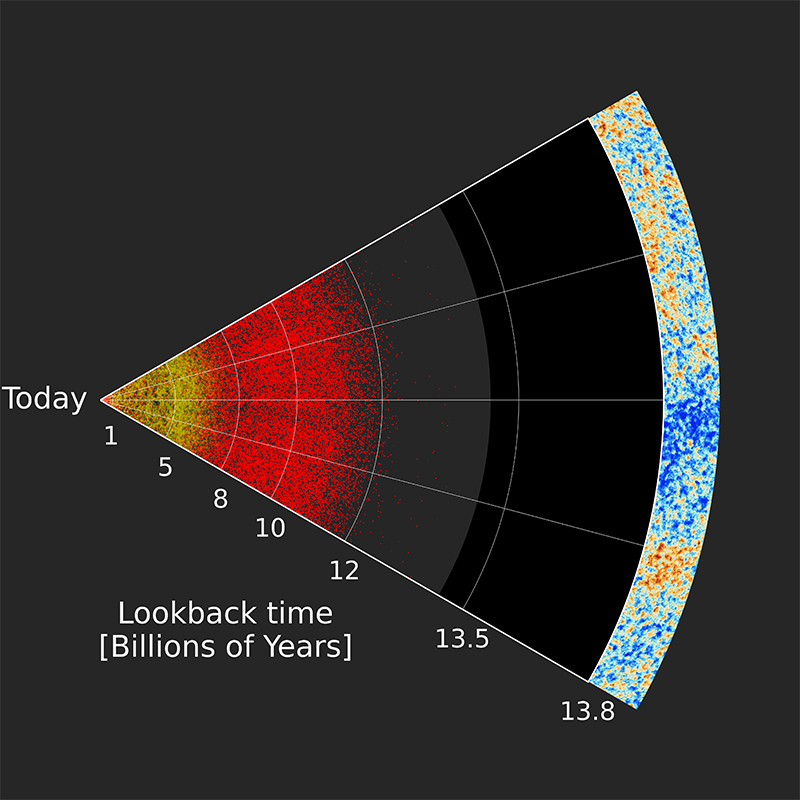The right-hand edge of the map is the limit of the observable Universe, from which we see the Cosmic Microwave Background (CMB) – the light “left over” from the Big Bang. The bulk of the empty space in between the quasars and the edge of the observable universe are from the “dark ages”, prior to the formation of most stars, galaxies, or quasars. Click on the image for a larger version.
Image Credit: Anand Raichoor (École polytechnique fédérale de Lausanne, Switzerland) and the SDSS collaboration
Astronomers with the Sloan Digital Sky Survey (SDSS) have created the first map of the large-scale structure of the Universe based entirely on the positions of quasars. Quasars are the incredibly bright and distant points of light powered by supermassive black holes.
“Because quasars are so bright, we can see them all the way across the Universe,” said Ashley Ross of the Ohio State University, the co-leader of the study. “That makes them the ideal objects to use to make the biggest map yet.”
The amazing brightness of quasars is due to the supermassive black holes found at their centers. As matter and energy fall into a quasar’s black hole, they heat up to incredible temperatures and begin to glow. It is this bright glow that is detected by a dedicated 2.5-meter telescope here on Earth.
“These quasars are so far away that their light left them when the Universe was between three and seven billion years old, long before the Earth even existed,” said Gongbo Zhao from the National Astronomical Observatories of Chinese Academy of Sciences, the study’s other co-leader.
To make their map, scientists used the Sloan Foundation Telescope to observe an unprecedented number of quasars. During the first two years of the SDSS’s Extended Baryon Oscillation Spectroscopic Survey (eBOSS), astronomers measured accurate three-dimensional positions for more than 147,000 quasars.
The telescope’s observations gave the team the quasars’ distances, which they used to create a three-dimensional map of where the quasars are. But to use the map to understand the expansion history of the Universe, they had to go a step further, using a clever technique involving studying “baryon acoustic oscillations” (BAOs). BAOs are the present-day imprint of sound waves which travelled through the early Universe, when it was much hotter and denser than the Universe we see today. But when the Universe was 380,000 years old, conditions changed suddenly and the sound waves became “frozen” in place. These frozen waves are left imprinted in the three-dimensional structure of the Universe we see today.
Gongbo Zhao
“These quasars are so far away that their light left them when the Universe was between three and seven billion years old, long before the Earth even existed.”
The good news about these frozen waves – the original baryon acoustic oscillations – is that the process that produced them is simple. Thus, we have a good understanding of what BAOs must have looked like at that ancient time. When we look at the three-dimensional structure of the Universe today, it contains these same BAOs grown out to a huge scale by the expansion of the Universe. The observed size of the BAO can be used as a “standard ruler” to measure distances. Just as by using the apparent angle of a meter stick viewed from the other side of a football field, you can estimate the length of the field. “You have meters for small units of length, kilometres or miles for distances between cities, and we have the BAO scale for distances between galaxies and quasars in cosmology,” explained Pauline Zarrouk, a PhD student at the Irfu/CEA, University Paris-Saclay, who measured the projected BAO scale.
Astronomers from the SDSS have previously used the BAO technique on nearby galaxies and then on intergalactic gas distributions to push this analysis farther and farther back in time. The current results cover a range of times where they have never been observed before, measuring the conditions when the Universe more than two billion years before the Earth formed.
The results of the new study confirm the standard model of cosmology that researchers have built over the last twenty years. In this standard model, the Universe follows the predictions of Einstein’s General Theory of Relativity — but includes components whose effects we can measure, but whose causes we do not understand. Along with the ordinary matter that makes up stars and galaxies, the Universe includes dark matter – invisible yet still affected by gravity – and a mysterious component called “Dark Energy.” Dark Energy is the dominant component at the present time, and it has special properties that cause the expansion of the Universe to speed up.
“Our results are consistent with Einstein’s theory of General Relativity” said Hector Gil-Marin, a researcher from the Laboratoire de Physique Nucléaire et de hautes Énergies in Paris who undertook key parts of the analysis. “We now have BAO measurements covering a range of cosmological distances, and they all point to the same thing: the simple model matches the observations very well.”
Even though we understand how gravity works, we still do not understand everything – there is still the question of what exactly dark energy is. “We would like to understand Dark Energy further,” said Will Percival from the University of Portsmouth, who is the eBOSS survey scientist. “Surveys like eBOSS are helping us to build up our understanding of how dark energy fits into the story of the Universe.”
The eBOSS experiment is still continuing, using the Sloan Telescope at Apache Point Observatory in New Mexico, USA. As astronomers with eBOSS observe more quasars and nearby galaxies, the size of their map will continue to increase. After eBOSS is complete, a new generation of sky surveys will begin, including the Dark Energy Spectroscopic Instrument (DESI) and the European Space Agency Euclid satellite mission. These will increase the fidelity of the maps by a factor of ten compared with eBOSS, revealing the Universe and Dark Energy in unprecedented detail.
Images
The right-hand edge of the map is the limit of the observable Universe, from which we see the Cosmic Microwave Background (CMB) – the light “left over” from the Big Bang. The bulk of the empty space in between the quasars and the edge of the observable universe are from the “dark ages”, prior to the formation of most stars, galaxies, or quasars. Click on the image for a larger version.
Image Credit: Anand Raichoor (École polytechnique fédérale de Lausanne, Switzerland) and the SDSS collaboration
Contacts
- Ashley Ross, The Ohio State University,
ashley.jacob.ross@gmail.com, +1 614 247 8102 - Gong Zhao, National Astronomical Observatories of the Chinese Academy of Sciences,
gbzhao@nao.cas.cn, +86 10 64806237 - Pauline Zarrouk, Institut de Recherche sur les lois Fondamentales de l’Univers / Commissariat à l’énergie atomique (IRFU/CEA), Université Paris-Saclay (France),
pauline.zarrouk@cea.fr, +33 1 69 08 45 56 - Will Percival, University of Portsmouth (UK),
will.percival@port.ac.uk, +44 (0)2392 843107 - Karen Masters, SDSS Scientific Spokesperson, University of Portsmouth,
Karen.Masters@port.ac.uk +44 (0)7590 526600, @KarenLMasters / @SDSSurveys - Jordan Raddick, SDSS Public Information Officer, Johns Hopkins University,
raddick@jhu.edu, +1 443 570 7105, @raddick
About the Sloan Digital Sky Survey
Funding for the Sloan Digital Sky Survey IV has been provided by the Alfred P. Sloan Foundation, the U.S. Department of Energy Office of Science, and the Participating Institutions. SDSS acknowledges support and resources from the Center for High-Performance Computing at the University of Utah. The SDSS web site is www.sdss.org.
SDSS is managed by the Astrophysical Research Consortium for the Participating Institutions of the SDSS Collaboration including the Brazilian Participation Group, the Carnegie Institution for Science, Carnegie Mellon University, the Chilean Participation Group, the French Participation Group, Harvard-Smithsonian Center for Astrophysics, Instituto de Astrofísica de Canarias, The Johns Hopkins University, Kavli Institute for the Physics and Mathematics of the Universe (IPMU) / University of Tokyo, Lawrence Berkeley National Laboratory, Leibniz Institut für Astrophysik Potsdam (AIP), Max-Planck-Institut für Astronomie (MPIA Heidelberg), Max-Planck-Institut für Astrophysik (MPA Garching), Max-Planck-Institut für Extraterrestrische Physik (MPE), National Astronomical Observatories of China, New Mexico State University, New York University, University of Notre Dame, Observatório Nacional / MCTI, The Ohio State University, Pennsylvania State University, Shanghai Astronomical Observatory, United Kingdom Participation Group, Universidad Nacional Autónoma de México, University of Arizona, University of Colorado Boulder, University of Oxford, University of Portsmouth, University of Utah, University of Virginia, University of Washington, University of Wisconsin, Vanderbilt University, and Yale University.




